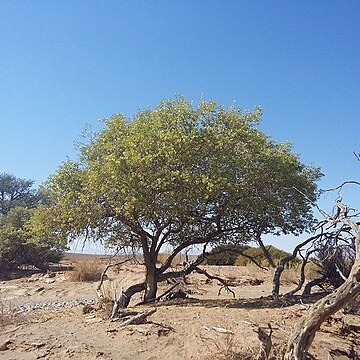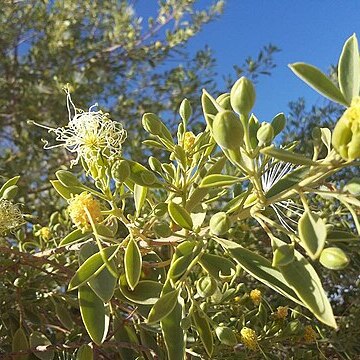Tree, usually erect, sometimes branched below, up to 7 m high; bark smooth, white or reddish brown; young branches yellowish green or beige, lenticellate, puberulous, rarely glabrous. Leaves simple, petiolate; lamina elliptic to ovate, 2-6 cm long, 1.1-3.5(-7.3) cm wide, apex obtuse, rounded or emarginate, mucronate, base broadly cuneate to rounded, margins entire, lateral veins 4, looping before margin, somewhat immersed, coriaceous, puberulous, sometimes glabrous, yellowish green; petiole 0.8-3.0 cm long, sometimes very slender, swollen and channelled in upper half, puberulous. Inflorescence of terminal racemes; pedicels 0.8-2.5 cm long, puberulous to tomentulose. Receptacle slender, infundibular or cylindric, 0.5-1.2 cm long, 2-3 mm wide at mouth, glabrous, puberulous or tomentulose; disc coronate, c. 2-5 mm long, unequally laciniate. Sepals 4, elliptic-obovate, 11-15 mm long, 5-8 mm wide, apex acute, obtuse or rounded, somewhat cucullate and apiculate, glabrous or puberulous. Petals 0. Androphore 5-7 mm long, equal or exerted 2 mm above receptacle. Stamens 30-70, 1.4-1.6 cm long; anthers oblong, 1.5-2 mm long. Gynophore 1.5-2 cm long. Ovary ellipsoid-cylindrical, 0.5-1 cm long; ovules 30-40; stigma capitate. Fruit moniliform, up to 12 cm long, 0.5-1 cm diam., faintly colliculate; seeds round, c. 0.5 cm diam., granulate.
More
A shrub or tree. It grows 3-7 m high. It has a dense rounded crown. The bark is smooth and can be whitish grey or reddish brown. The leaves are 4-6 cm long and 2-3 cm wide. They are oval. The flowers are white or cream. The fruit are long narrow capsules. They are constricted between the seeds.



